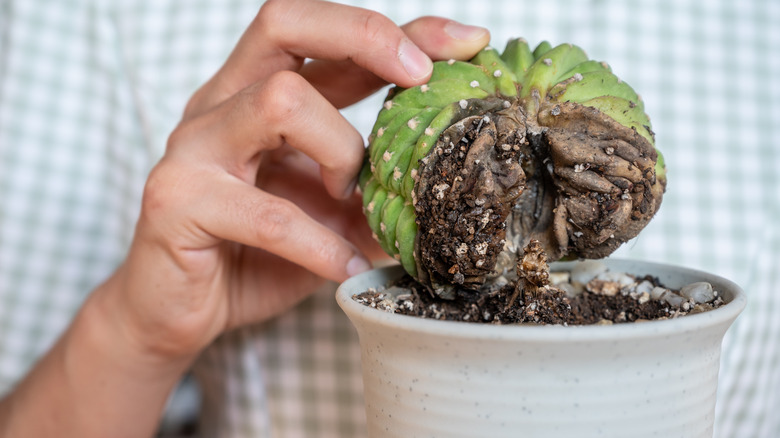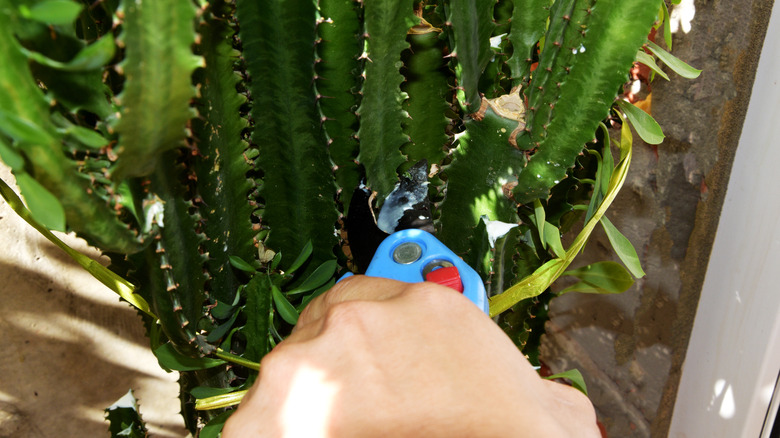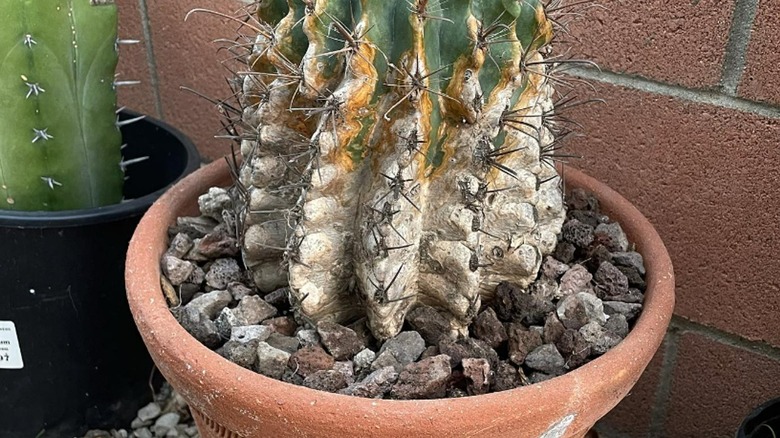Why Your Cactus Is Turning Brown (And What To Do About It)
Cacti are pretty easygoing, and being that they're from the desert, they also thrive under neglect. That being said, if you notice your spiky green child has begun to turn a less-than-vibrant brown, that can be caused by more than a few factors, which are all relatively easy to fix. Aside from the standard too much or too little water, other culprits that can contribute to the sudden deterioration of your cactus kid include excessive light, overwatering, pests, diseases, and even old age.
When trying to determine what the exact cause is, you'll have to get real and ask yourself if you've been a bit forgetful when it comes to feeding and watering, or if you've become the plant version of a helicopter parent and provided it with too much. Insufficient light can trigger leggy growth, while too much light can result in sunburn, which is most recognizable by those characteristic nasty brown scorch marks. During winter, cacti should be watered less frequently, because they're sleeping and require less moisture. The slower uptake of water means that the soil remains damp for longer periods. Make sure you're using pots with drainage holes and potting soil that retains enough moisture.
How to resurrect your cactus buddy
Most cacti are adapted to arid climates with low rainfall, minimal humidity, and well-draining sandy soil. So keep your cactus happy and green and try to replicate its natural conditions as much as possible. This should be your first line of defense against your cactus beginning to rot. It's important to keep in mind that the cactus is a desert plant, which means unlike most other houseplants, this baby will keep drinking water until there's nothing left. If you keep on providing fluids, you can expect your cactus to go south. Excessive moisture can cause root and stem rot, which results in the softening and browning of your poor little untouchable plant. If this is the case, carefully trim the healthy stems so that a new plant can propagate.
A firm brown patch on the healthy part of the cactus could mean it has a fungus. You'll want to use a fungicide to prevent it from spreading. Unfortunately, this can leave scars, but that's better than losing your entire plant. Firm brown spots might also be from an infestation where bugs are literally sucking the life out of your plant. To resolve this issue, apply neem oil or use a Q-tip dipped in 70 percent isopropyl alcohol, which will quickly send these pests back to meet their maker.
Maybe it's just past its prime
If you notice your cactus displaying a brown hue around its stem base or stems, it might be undergoing a process known as corking. This is a completely natural phenomenon that manifests in mature plants. If the brown portion looks somewhat fibrous or has a wood-like texture, then rest assured that this is just part of the cacti's normal aging process and that it shouldn't be anything to be concerned about.
That being said, because this is considered to be somewhat of a stress response, if you see corking developing at the base of the plant, just keep it in its pot. Repotting it may lead to the development of new cork due to roots that are emerging from a less-than-ideal area of the plant. This can potentially lead to structural issues later down the line. Infrequent waterings mimic what a cactus experiences out in the wild, so always allow it to fully dry out before giving it another drink.


